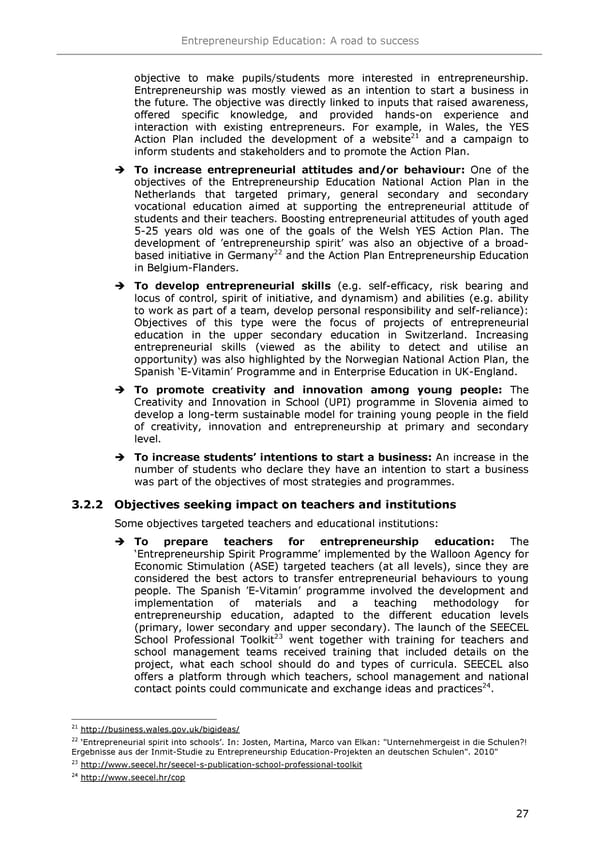Entrepreneurship Education: A road to success objective to make pupils/students more interested in entrepreneurship. Entrepreneurship was mostly viewed as an intention to start a business in the future. The objective was directly linked to inputs that raised awareness, offered specific knowledge, and provided hands-on experience and interaction with existing entrepreneurs. For example, in Wales, the YES 21 Action Plan included the development of a website and a campaign to inform students and stakeholders and to promote the Action Plan. To increase entrepreneurial attitudes and/or behaviour: One of the objectives of the Entrepreneurship Education National Action Plan in the Netherlands that targeted primary, general secondary and secondary vocational education aimed at supporting the entrepreneurial attitude of students and their teachers. Boosting entrepreneurial attitudes of youth aged 5-25 years old was one of the goals of the Welsh YES Action Plan. The development of 9entrepreneurship spirit9 was also an objective of a broad- 22 based initiative in Germany and the Action Plan Entrepreneurship Education in Belgium-Flanders. To develop entrepreneurial skills (e.g. self-efficacy, risk bearing and locus of control, spirit of initiative, and dynamism) and abilities (e.g. ability to work as part of a team, develop personal responsibility and self-reliance): Objectives of this type were the focus of projects of entrepreneurial education in the upper secondary education in Switzerland. Increasing entrepreneurial skills (viewed as the ability to detect and utilise an opportunity) was also highlighted by the Norwegian National Action Plan, the Spanish 8E-Vitamin9 Programme and in Enterprise Education in UK-England. To promote creativity and innovation among young people: The Creativity and Innovation in School (UPI) programme in Slovenia aimed to develop a long-term sustainable model for training young people in the field of creativity, innovation and entrepreneurship at primary and secondary level. To increase students9 intentions to start a business: An increase in the number of students who declare they have an intention to start a business was part of the objectives of most strategies and programmes. 3.2.2 Objectives seeking impact on teachers and institutions Some objectives targeted teachers and educational institutions: To prepare teachers for entrepreneurship education: The 8Entrepreneurship Spirit Programme9 implemented by the Walloon Agency for Economic Stimulation (ASE) targeted teachers (at all levels), since they are considered the best actors to transfer entrepreneurial behaviours to young people. The Spanish 9E-Vitamin9 programme involved the development and implementation of materials and a teaching methodology for entrepreneurship education, adapted to the different education levels (primary, lower secondary and upper secondary). The launch of the SEECEL School Professional Toolkit23 went together with training for teachers and school management teams received training that included details on the project, what each school should do and types of curricula. SEECEL also offers a platform through which teachers, school management and national contact points could communicate and exchange ideas and practices24. 21 http://business.wales.gov.uk/bigideas/ 22 8Entrepreneurial spirit into schools9. In: Josten, Martina, Marco van Elkan: "Unternehmergeist in die Schulen?! Ergebnisse aus der Inmit-Studie zu Entrepreneurship Education-Projekten an deutschen Schulen". 2010" 23 http://www.seecel.hr/seecel-s-publication-school-professional-toolkit 24 http://www.seecel.hr/cop 27
 Entrepreneurship Education Page 30 Page 32
Entrepreneurship Education Page 30 Page 32